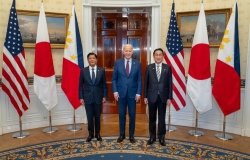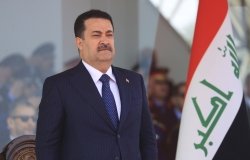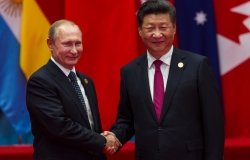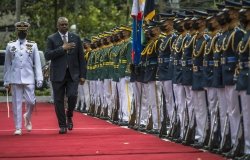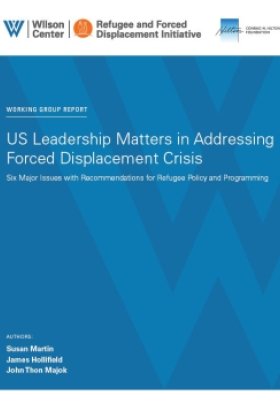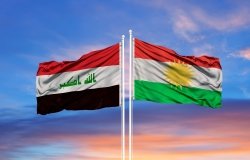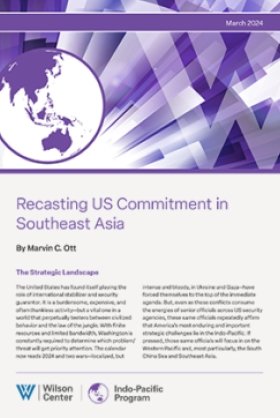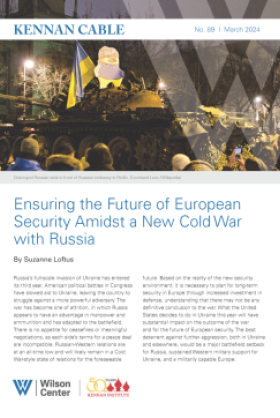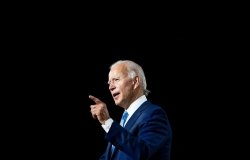Can Iran Serve Biden to Overcome Yet Another Nadir in US-Saudi Relations?
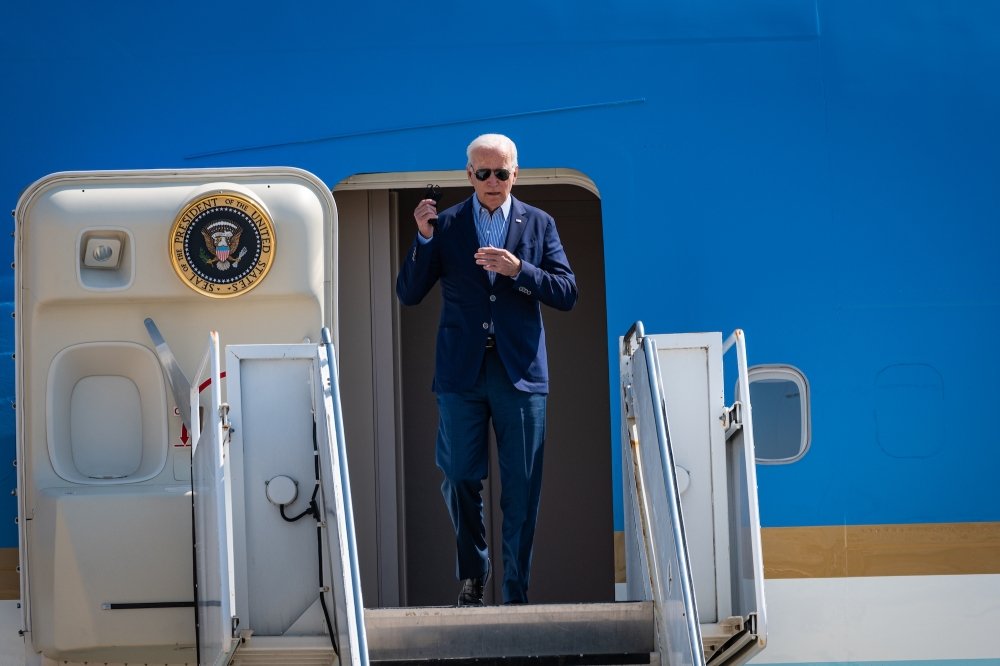
Chris Allan / shutterstock.com
Major crises in US-Saudi relations over the past eight decades have brought the two countries to near divorce before. Twice they were overcome by finding a common cause to rebind and rebuild their troubled relationship. Iran may serve that purpose in the current crisis, and President Biden’s trip to Israel and Saudi Arabia this week will likely signal whether or not it will.
In any case, the cost to Biden for seeking to salvage America’s oldest alliance in the Arab Middle East is already clear: the abandonment of his “pariah policy” toward Saudi Arabia’s de facto ruler, Crown Prince Mohammed bin Salman (MBS). This came in response to Mohammed’s authorization of the murder of well-known Saudi journalist Jamal Khashoggi inside the Saudi consulate in Istanbul in October 2018. It remains murky, however, what Biden may reap in return for his striking about-face.
The first crises
A review of how two other crises were resolved may be helpful in assessing whether Biden will find a way out of the current one. It is worth noting the similarities and differences among the three to better judge his chances for success or failure.
The boycott had an outsized impact on American consumers as the US had just become dependent for the first time on imported oil to meet soaring domestic demand.
The first crisis caught Washington totally by surprise. It was touched off by the 1973 Arab-Israeli War and the Saudi decision to initiate an oil boycott of the United States in retaliation for its military and political support of the Jewish state. The boycott had an outsized impact on American consumers as the US had just become dependent for the first time on imported oil to meet soaring domestic demand. The result of the boycott, which other Gulf Arab producers joined, was long lines outside gasoline stations and even quotas on the amount of gallons sold to customers.
The boycott lasted only a few months, and the Nixon administration found common cause with the Saudis by launching programs to help them recycle their billions of dollars reaped from higher oil prices into the building of a modern Saudi state; especially in its economy and armed forces. The relationship actually became far stronger and more broad-based.
The second major crisis was touched off by the al-Qaeda attacks on the US homeland on September 11, 2001. It saw 19 terrorists, 15 of them Saudi nationals, highjack three commercial airlines and fly two of them into the Twin Towers in New York City and the Pentagon in Washington, killing nearly 3,000 Americans. This time, both the US and Saudi leaderships were shocked and grappled mightily to deal with the enormous impact on their relationship, being that the terrorists’ attacks involved so many Saudis, including the mastermind Osama bin Laden.
The 9/11 crisis marked the end of what both sides used to call a “special relationship”, highlighted by their close cooperation in the 1990-91 Gulf War. At the time, the United States and Saudi Arabia jointly led a collation of Arab and Western armies which ousted Iraqi forces that Saddam Hussein had sent to take over neighboring Kuwait.
After the 9/11 terrorist attacks, Congress established a bipartisan commission in November 2002 to investigate who was responsible. After almost two years, it produced a report absolving the Saudi leadership of any direct involvement. Still, to this day, a lawsuit brought by the families of those who died in the attacks continues in a US court aimed at proving Saudi government culpability for the attacks and demanding compensation.
Restart at Crawford
It also took nearly two years before US and Saudi leaders would meet to discuss ways to get the badly damaged relationship back on track. The prelude saw then Saudi Crown Prince Abdullah, the kingdom’s de facto ruler, produce a peace plan offering Israel normalization of relations with the Arab world in return for its agreement to allow the establishment of a Palestinian state. The Saudi plan was formally adopted by the 22-member Arab League at its annual summit in March 2002.
The next month, on April 25, President George W. Bush invited Abdullah to his home in Crawford, Texas for a kiss-and-make-up session that turned out to be a near disaster. The two leaders talked past each other; Abdullah focused on a resolution to the Palestinian question and Bush on the dangers from terrorism and Saddam Hussein’s regime in Iraq. Secretary of State Colin Powell later described their five-hour meeting as an “ugly scene,” and no joint statement was issued at the end of Abdullah’s visit.
Bush went to extraordinary lengths to welcome the Saudi crown prince, kissing him on both cheeks and taking his hand to guide him down the path to his ranch.
Not until a second meeting between the two leaders, again in Crawford, and on the same date three years later—four years after the 9/11 attacks—did the two sides make progress on repairing the U.S.-Saudi relationship. This time, Bush went to extraordinary lengths to welcome the Saudi crown prince, kissing him on both cheeks and taking his hand to guide him down the path to his ranch. This time, too, both leaders went out of their way to emphasize their strong personal friendship.
Like today, the focus of the 2005 U.S.-Saudi summit was the high price of oil. Abdullah presented Bush with a Saudi plan to spend $50 billion on boosting the kingdom’s production up to 12.5 million barrels a day by 2010 and to 15 million barrels later. The two also agreed to relaunch the relationship under a joint commission led by their foreign ministers to outline a new “strategic dialogue” to replace the old “special relationship.” They also set up six working groups dealing with various issues from terrorism to energy and US investments in the Saudi economy, in addition to ways to improve the perception of Saudi Arabia among Americans. Abdullah announced a multi-billion-dollar scholarship program that would see tens of thousands of Saudi students come to American universities in the following years.
The two easily found a common cause in combating Islamic extremism and terrorism, which after 9/11, the Saud royal family realized was also becoming a real threat to its survival, particularly after al-Qaeda began in 2003 launching attacks inside the capital, Riyadh.
Biden’s dilemma
The question now is this: Will Biden’s meeting with the current Saudi crown prince and de facto ruler resemble more Bush’s first “ugly” meeting with Abdullah in 2002 or his second, kiss-and-make-up meeting in 2005? And will the two sides announce a new common cause in dealing with Iran and its nuclear ambitions?
The respective White House and Saudi press releases announcing Biden’s visit on July 15-16 do not augur well for the two leaders establishing a close personal tie – always a key factor in the state of overall US-Saudi relations. The Saudi one states Biden will first meet with King Salman as protocol would dictate. It then says the US president will “hold official talks” with Crown Prince Mohammed and discuss everything from space, renewable energy, the climate, expanded trade and commercial ties to how the two governments will “seize the opportunities of the 21st century.” The White House version, however, does not even mention that Biden will meet with the crown prince. A senior administration official has since admitted Biden will indeed meet MBS, but only in the context of a larger summit with other Gulf Arab leaders.
Also, distinctly different from the Bush-Abdullah meeting, oil apparently will not be the focus as the prospect for Saudi help to alleviate high gasoline prices remain slim. At least that is what Biden told reporters before the official announcement of his visit, referring to unnamed “commitments” from the Saudis that “don’t relate to anything having to do with energy.”
This is probably true. The Saudis are sticking to the latest agreement of the 13-member Organization of Petroleum Exporting Countries (OPEC), plus 1O other producers led by Russia, only to increase their collective production from 432,000 barrels a day to 648,000 barrels in July and August. This was an empty gesture since OPEC+ has fallen far behind its past commitments to increase production. Due to the boycott of Russian oil by Western nations in response to its invasion of Ukraine, Russia alone was 1.3 million barrels a day behind its quota in May. So far, the Saudis have made no offer to make up for the Russian shortfall, nor the chronic ones of Nigeria, Angola and Libya.
As in the Bush-Abdullah meeting, the aim seems to be to revitalize the relationship at the bottom even if at the top personal ties between Biden and MBS remain cool, which seems highly likely.
The main similarity between the 2005 Bush-Abdullah meeting and the Biden-MBS one appears in a US Department of Commerce June 15 press release. It announced the establishment of a US-Saudi Commercial Partnership Shared Work Plan to “promote deeper cooperation” in four areas: the green economy, strengthening the role of women, supporting small and medium enterprises, promoting innovation and increased investment in each other’s country. As in the Bush-Abdullah meeting, the aim seems to be to revitalize the relationship at the bottom even if at the top personal ties between Biden and MBS remain cool, which seems highly likely.
Betting on the Abraham Accords
Biden is casting the focus of his trip instead on his meeting with the six Arab monarchies of the Gulf Cooperation Council (GCC) plus the leaders of Egypt, Jordan and Iraq. This appears to be another attempt to stand up a US-backed Arab alliance to counter Iran, now made more urgent by that country’s continuing steps toward building a nuclear bomb. Former President Trump tried but failed to establish the Middle East Strategic Alliance after he withdrew the United States from the 2015 agreement limiting Iran’s nuclear program.
Since Trump pulled out of the Iranian nuclear deal in 2018, the Iranians have also progressively abandoned its terms, notably by increasing its stockpile of near-nuclear-grade enriched uranium. Biden has tried, but so far failed, to convince Iran to restore those limits. This is increasing the pressure on Biden to make clear what he intends to do, given his promise to keep Iran from obtaining a nuclear weapon “on my watch.”
Iran looms as the obvious candidate to become the common cause needed to revitalize the US-Saudi relationship and to expand it to include Israel, also determined to stop Iran from having nuclear weapons. Israeli Defense Minister Benny Gantz told the Knesset on June 20 that Israel has already begun establishing a “Middle East Air Defense Alliance” with unnamed partners to counter Iran’s missile threat. He described the alliance as “already operative” and claimed it successfully stopped several Iranian attempts to attack Israel “and other countries.”
His statement is bound to raise speculation that not only is the United States an active participant in such an alliance but also Israel’s new Gulf Arab partners in the 2020 Abraham Accords. These accords saw the United Arab Emirates (UAE) and Bahrain establish diplomatic relations with Israel. Saudi Arabia declined to follow suit at the time, but its leaders have made clear it is also ready for diplomatic ties, provided Israel takes some steps to settle the Palestinian issue.
On the other hand, three other GCC members—Qatar, Oman and Kuwait—have shown little interest in joining either the accords or an overt anti-Iranian alliance, the same reaction they displayed to Trump’s failed proposal for a Middle East Strategic Alliance. The UAE also seems decidedly skittish. It was among six Arab states which attended a secret meeting of top military commanders together with American and Israeli ones held at Sharm el-Sheikh in Egypt in March. The UAE government later issued a statement stating it was “not party to any regional military alliance targeting ant specific country” and was “not aware” of any such discussions of one.
This would help him justify the abandonment of his 'pariah policy' toward MBS as would an iteration of Trump’s Middle East Strategic Alliance.
Biden may announce, while in Israel on July 13-14, that Saudi Arabia has agreed to give Israel expanded overflight rights for its commercial planes flying to Asia. It has already done this for those headed for the UAE and Bahrain. The President may also declare that Israel and Saudi Arabia have reached an agreement on their dispute over two islands in the Straits of Tiran leading into the Gulf of Aqaba. He would doubtlessly love to announce as well that Saudi Arabia is ready to join the Abraham Accords. This would help him justify the abandonment of his “pariah policy” toward MBS as would an iteration of Trump’s Middle East Strategic Alliance. It seems unlikely, however, that Biden will achieve either goal, leaving him exposed to criticisms that his trip only helped Israel while leaving the United States still exposed to record-high gasoline prices.
The Future of the Alliance
Even the odds for establishing a smaller trilateral alliance seem long. MBS regards Iran as Saudi Arabia’s foremost foe and has promised to build a nuclear bomb if it does. Still, whether he is ready to risk an overt military confrontation even alongside the United States and Israel remains questionable. Iran attacked the kingdom with drones and cruise missiles in September 2019, hitting two critical Saudi oil facilities and knocking out half its production. The United States neither foresaw the attack, nor was it able to help the Saudis prevent the drones and missiles from reaching their targets. This was clearly an Iranian warning of the potential cost to Saudi Arabia of siding with the United States and Israel in any military venture against it.
The views expressed in these articles are those of the author and do not reflect an official position of the Wilson Center.
About the Author


Middle East Program
The Wilson Center’s Middle East Program serves as a crucial resource for the policymaking community and beyond, providing analyses and research that helps inform US foreign policymaking, stimulates public debate, and expands knowledge about issues in the wider Middle East and North Africa (MENA) region. Read more


